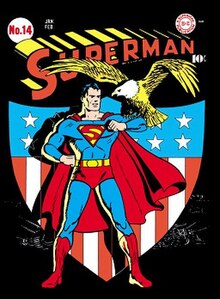
A comic book, also called comicbook, comic magazine or simply comic, is a publication that consists of comics art in the form of sequential juxtaposed panels that represent individual scenes. Panels are often accompanied by descriptive prose and written narrative, usually, dialogue contained in word balloons emblematic of the comics art form.
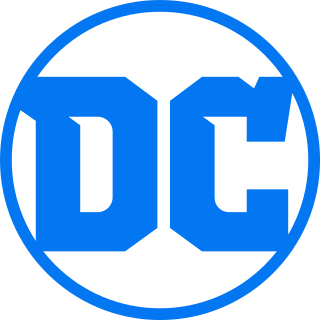
DC Comics, Inc. is an American comic book publisher and the flagship unit of DC Entertainment, a subsidiary of Warner Bros. Discovery. DC is an initialism for "Detective Comics", an American comic book series first published in 1937.
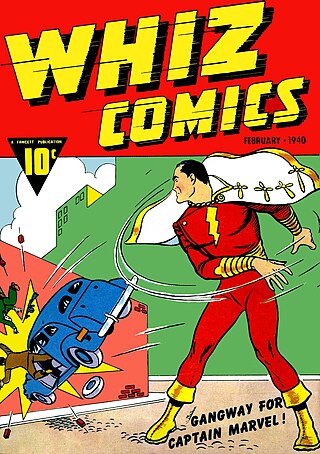
A superhero or superheroine is a stock character who typically possesses superpowers or abilities beyond those of ordinary people, is frequently costumed concealing their identity, and fits the role of the hero; typically using their powers to help the world become a better place, or dedicating themselves to protecting the public and fighting crime. Superhero fiction is the genre of fiction that is centered on such characters, especially, since the 1930s, in American comic books, as well as in Japanese media.

The Silver Age of Comic Books was a period of artistic advancement and widespread commercial success in mainstream American comic books, predominantly those featuring the superhero archetype. Following the Golden Age of Comic Books, the Silver Age is considered to cover the period from 1956 to 1970, and was succeeded by the Bronze Age.

The Justice League, or Justice League of America (JLA), is a group of superheroes appearing in American comic books published by DC Comics. The team first appeared in The Brave and the Bold #28. The team was conceived by writer Gardner Fox as a revival of the Justice Society of America, a similar team from DC Comics from the 1940s which had been pulled out of print due to a decline in sales.

An American comic book is a thin periodical originating in the United States, on average 32 pages, containing comics. While the form originated in 1933, American comic books first gained popularity after the 1938 publication of Action Comics, which included the debut of the superhero Superman. This was followed by a superhero boom that lasted until the end of World War II. After the war, while superheroes were marginalized, the comic book industry rapidly expanded and genres such as horror, crime, science fiction and romance became popular. The 1950s saw a gradual decline, due to a shift away from print media in the wake of television and the impact of the Comics Code Authority. The late 1950s and the 1960s saw a superhero revival and superheroes remained the dominant character archetype throughout the late 20th century into the 21st century.

Nelson Alexander Ross is an American comic book writer and artist known primarily for his painted interiors, covers, and design work. He first became known with the 1994 miniseries Marvels, on which he collaborated with writer Kurt Busiek for Marvel Comics. He has since done a variety of projects for both Marvel and DC Comics, such as the 1996 miniseries Kingdom Come, which he also cowrote. Since then he has done covers and character designs for Busiek's series Astro City, and various projects for Dynamite Entertainment. His feature film work includes concept and narrative art for Spider-Man (2002) and Spider-Man 2 (2004), and DVD packaging art for the M. Night Shyamalan film Unbreakable (2000). He has done covers for TV Guide, promotional artwork for the Academy Awards, posters and packaging design for video games, and his renditions of superheroes have been merchandised as action figures.
In American comic books and other stories with a long history, first appearance refers to the first issue to feature a fictional character. These issues are often highly valued by collectors due to their rarity and iconic status.
DC Archive Editions was a line of hardcovers which ran from 1989–2014, reprinting early, often rare comic book series, titles, and stories. They include more than 160 Golden Age and Silver Age comic properties currently owned by DC Comics, regardless of whether DC Comics was the original publisher. The series first published Superman Archives Vol. 1 in 1989. Most of the restoration work to make the pages suitable for quality printing has been done by Rick Keene, who has restored more than 2,500 pages.

Carmine Infantino was an American comics artist and editor, primarily for DC Comics, during the late 1950s and early 1960s period known as the Silver Age of Comic Books. Among his character creations are the Black Canary and the Silver Age version of DC superhero the Flash with writer Robert Kanigher, the stretching Elongated Man with John Broome, Barbara Gordon the second Batgirl with writer Gardner Fox, Deadman with writer Arnold Drake, and Christopher Chance, the second iteration of the Human Target with Len Wein.
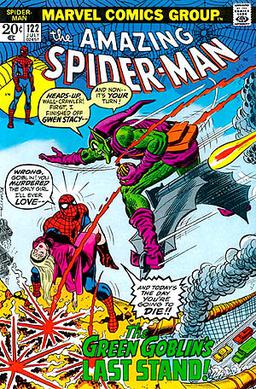
The Bronze Age of Comic Books is an informal name for a period in the history of American superhero comic books, usually said to run from 1970 to 1985. It follows the Silver Age of Comic Books and is followed by the Modern Age of Comic Books.

Whiz Comics was an anthology comic book series published by former American comic book publishing company, Fawcett Publications between February 1940 until June 1953. It is widely known for being the comic run in which hugely popular superhero character Captain Marvel (Shazam) made his debut.

National Comics Publications v. Fawcett Publications, 191 F.2d 594. was a decision by the United States Court of Appeals for the Second Circuit in a twelve-year legal battle between National Comics and the Fawcett Comics division of Fawcett Publications, concerning Fawcett's Captain Marvel character being an infringement on the copyright of National's Superman comic book character. The litigation is notable as one of the longest-running legal battles in comic book publication history.
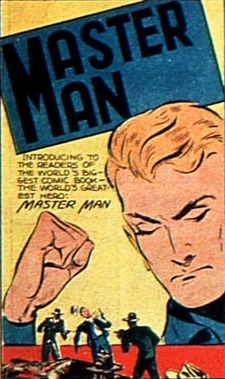
Master Man is a fictional character created during the 1930s to 1940s period referred to as the Golden Age of Comic Books. A superhero, the character's exact creator is uncertain: his first story, in Fawcett Comics' Master Comics #1, was drawn by Newt Alfred, but that issue's cover was drawn by Harry Fiske. The leader character in the anthology Master Comics, he was described as:
"...the world's greatest hero: Master Man! Stronger than untamed horses! Swifter than raging winds! Braver than mighty lions! Wiser than wisdom, kind as Galahad is Master Man, the wonder of the world! As a boy, young Master Man was weak until a wise old doctor gave the youth a magic capsule, full of vitamins, containing every source of energy known to man! The boy becomes the strongest man on earth! Upon the highest mountain peak he built a solid castle made of solid rock! From there he sees all evil in the world and races to destroy it instantly!"
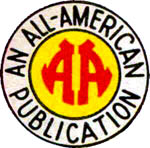
All-American Publications, Inc. was one of two American comic book companies that merged to form the modern-day DC Comics, one of the two largest publishers of comic books in the United States. Superheroes created for All-American include the original Atom, Flash, Green Lantern, Hawkman, and Wonder Woman, all in the 1940s' Golden Age of Comic Books.
The portrayal of women inAmerican comic books has often been the subject of controversy since the medium's beginning. Critics have noted the roles of women as both supporting characters and lead characters are substantially more subjected to gender stereotypes, with femininity and/or sexual characteristics having a larger presence in their overall character.

Superhero fiction is a subgenre of science fiction examining the adventures, personalities and ethics of costumed crime fighters known as superheroes, who often possess superhuman powers and battle similarly powered criminals known as supervillains. The genre primarily falls between hard fantasy and soft science fiction in the spectrum of scientific realism. It is most commonly associated with American comic books, though it has expanded into other media through adaptations and original works.

Superhero comics is one of the most common genres of American comic books. The genre rose to prominence in the 1930s and became extremely popular in the 1940s and has remained the dominant form of comic book in North America since the 1960s. Superhero comics feature stories about superheroes and the universes these characters inhabit.
The history of American comics began in the 19th century in mass print media, in the era of sensationalist journalism, where newspaper comics served as further entertainment for mass readership. In the 20th century, comics became an autonomous art medium and an integral part of American culture.

The 1940s were an essential time for DC Comics. Both National Comics Publications and All-American Publications would introduce many new featured superheroes in American comic books in superhero comics anthology tales like More Fun Comics, Adventure Comics, Detective Comics, Action Comics, All-American Comics, Superman, Flash Comics, Batman, All Star Comics, World's Finest Comics, All-Flash, Star Spangled Comics, Green Lantern, Leading Comics, Sensation Comics, Wonder Woman, Comic Cavalcade and Superboy that would be a staple for the comic book company. Examples of the superheroes include the Flash, Hawkman and Hawkgirl, Johnny Thunder and Thunderbolt, Spectre, Hourman, Robin, Doctor Fate, Congo Bill, Green Lantern, Atom, Manhunter, Doctor Mid-Nite, Sargon the Sorcerer, Starman, Johnny Quick, the Shining Knight, the Star-Spangled Kid and Stripesy, Tarantula, Vigilante, Green Arrow and Speedy, Aquaman, Wonder Woman, Sandy, the Golden Boy, Mister Terrific, Wildcat, Air Wave, Guardian, Robotman, TNT and Dan the Dyna-Mite, Liberty Belle, Superboy and Black Canary. These characters would later crossover in superhero team titles in the 1940s such as the Justice Society of America and the Seven Soldiers of Victory helping pave a way to a shared universe of the publication company. Other used featured characters outside of superheroes included kid titular heroes like the Newsboy Legion and the Boy Commandos. Later Western heroes would be used such as Johnny Thunder, Nighthawk and Pow Wow Smith.
